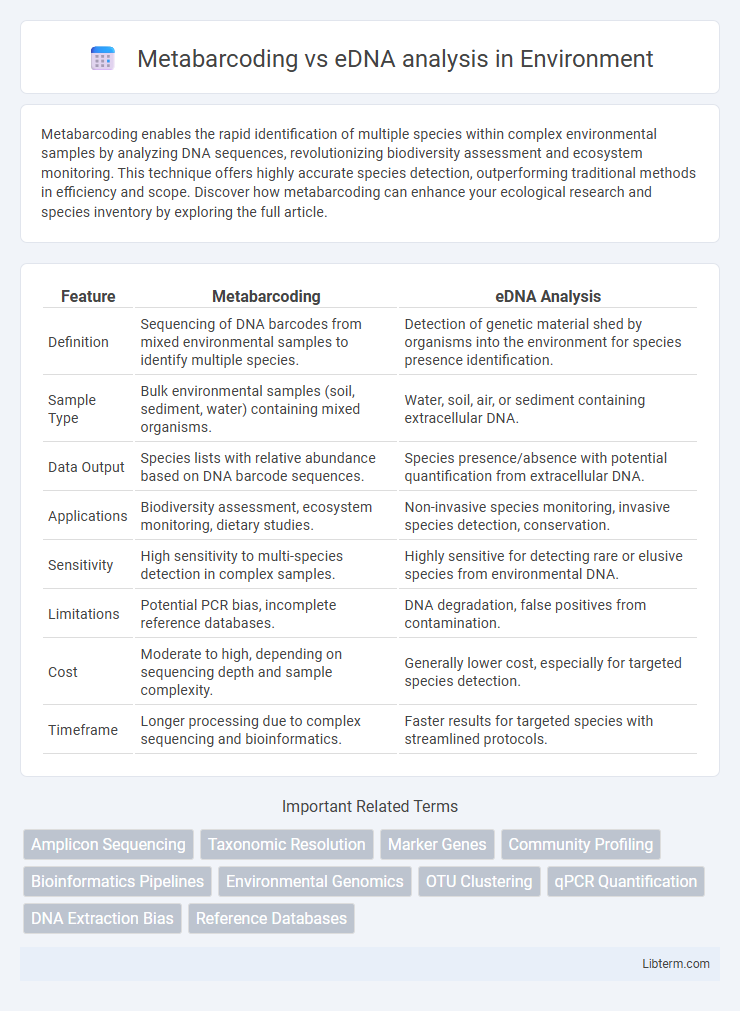Metabarcoding enables the rapid identification of multiple species within complex environmental samples by analyzing DNA sequences, revolutionizing biodiversity assessment and ecosystem monitoring. This technique offers highly accurate species detection, outperforming traditional methods in efficiency and scope. Discover how metabarcoding can enhance your ecological research and species inventory by exploring the full article.
Table of Comparison
| Feature | Metabarcoding | eDNA Analysis |
|---|---|---|
| Definition | Sequencing of DNA barcodes from mixed environmental samples to identify multiple species. | Detection of genetic material shed by organisms into the environment for species presence identification. |
| Sample Type | Bulk environmental samples (soil, sediment, water) containing mixed organisms. | Water, soil, air, or sediment containing extracellular DNA. |
| Data Output | Species lists with relative abundance based on DNA barcode sequences. | Species presence/absence with potential quantification from extracellular DNA. |
| Applications | Biodiversity assessment, ecosystem monitoring, dietary studies. | Non-invasive species monitoring, invasive species detection, conservation. |
| Sensitivity | High sensitivity to multi-species detection in complex samples. | Highly sensitive for detecting rare or elusive species from environmental DNA. |
| Limitations | Potential PCR bias, incomplete reference databases. | DNA degradation, false positives from contamination. |
| Cost | Moderate to high, depending on sequencing depth and sample complexity. | Generally lower cost, especially for targeted species detection. |
| Timeframe | Longer processing due to complex sequencing and bioinformatics. | Faster results for targeted species with streamlined protocols. |
Introduction to Metabarcoding and eDNA Analysis
Metabarcoding and eDNA analysis are advanced molecular techniques used for biodiversity assessment by detecting DNA fragments released into environments. Metabarcoding employs high-throughput sequencing to amplify specific genetic markers from mixed environmental samples, enabling simultaneous identification of multiple species. Environmental DNA (eDNA) analysis captures, extracts, and quantifies genetic material from water, soil, or air samples to monitor ecosystem health and species presence with minimal disturbance.
Fundamental Principles of Metabarcoding
Metabarcoding relies on high-throughput sequencing of standardized genetic markers, typically mitochondrial or ribosomal regions, to identify multiple species within complex environmental samples simultaneously. This technique amplifies target DNA fragments using universal primers, enabling comprehensive biodiversity assessments by matching sequences against reference databases. Metabarcoding's fundamental principle hinges on detecting species-specific barcodes from mixed-community DNA, offering precise taxonomic resolution and expediting ecological monitoring.
Key Concepts of Environmental DNA (eDNA) Analysis
Environmental DNA (eDNA) analysis involves collecting genetic material shed by organisms into their environment, allowing for non-invasive monitoring of biodiversity. Metabarcoding is a technique within eDNA analysis that uses high-throughput DNA sequencing to identify multiple species simultaneously based on specific genetic markers. Key concepts include sample collection, DNA extraction, amplification of target gene regions, sequencing, and bioinformatics analysis to interpret community composition and species presence.
Methodological Differences: Metabarcoding vs eDNA
Metabarcoding involves targeting specific genetic markers within environmental DNA (eDNA) samples to identify multiple species simultaneously, using high-throughput sequencing technologies. eDNA analysis broadly encompasses the extraction and detection of DNA shed by organisms into their environment, often applied for presence/absence monitoring without necessarily employing barcoding regions. Methodological differences center on metabarcoding's use of universal primers and bioinformatics pipelines to assess biodiversity, whereas general eDNA analysis may rely on species-specific assays like qPCR for targeted detection.
Sample Collection and Processing Techniques
Metabarcoding relies on bulk environmental samples, such as soil, water, or sediment, which are homogenized and subjected to DNA extraction to amplify target genetic markers. eDNA analysis typically involves collecting filtered water or air samples to capture extracellular DNA fragments, followed by sensitive extraction methods optimized for low-concentration, degraded DNA. Both techniques require stringent contamination controls and specialized protocols to preserve DNA integrity during collection and processing.
Sensitivity and Specificity in Species Detection
Metabarcoding offers high sensitivity by amplifying target DNA sequences, enabling detection of multiple species within complex environmental samples. eDNA analysis demonstrates remarkable specificity through the use of species-specific primers or probes, reducing false positives by accurately identifying target organisms. Combining metabarcoding with eDNA analysis enhances both sensitivity and specificity, providing robust species detection in biodiversity monitoring.
Applications in Biodiversity Assessment
Metabarcoding and eDNA analysis are powerful tools for biodiversity assessment, enabling the identification of multiple species from environmental samples such as soil, water, or air. Metabarcoding uses high-throughput sequencing of specific DNA barcode regions to detect species presence and community composition, while eDNA analysis targets DNA fragments shed by organisms, providing a non-invasive method for monitoring rare or elusive species. These techniques enhance ecosystem monitoring, improve conservation strategies, and facilitate rapid biodiversity inventories in diverse habitats worldwide.
Limitations and Challenges in Both Approaches
Metabarcoding faces limitations such as primer bias, which can skew species detection, and challenges in distinguishing closely related taxa due to marker resolution constraints. eDNA analysis encounters issues with DNA degradation in aquatic environments, contamination risks, and difficulties in quantifying organism abundance accurately. Both methods require meticulous sample collection protocols and robust bioinformatics pipelines to reduce false positives and ensure reliable biodiversity assessments.
Recent Advancements and Emerging Trends
Recent advancements in metabarcoding and eDNA analysis have significantly enhanced biodiversity monitoring through improved high-throughput sequencing technologies and more sensitive detection primers. Emerging trends include the integration of machine learning algorithms for data interpretation and the expansion of portable, field-deployable sequencing platforms that enable real-time environmental assessments. These innovations streamline species identification and ecological assessments, driving more accurate and comprehensive ecosystem management strategies.
Future Perspectives in Molecular Ecosystem Monitoring
Metabarcoding and eDNA analysis are revolutionizing molecular ecosystem monitoring by enabling precise biodiversity assessments through high-throughput sequencing of environmental samples. Future perspectives highlight integration with automated sampling technologies and AI-driven data analytics to enhance real-time ecosystem health monitoring and early detection of invasive species. Advances in reference databases and improved primer design will further increase taxonomic resolution and detection sensitivity, fostering more comprehensive ecosystem management strategies.
Metabarcoding Infographic

 libterm.com
libterm.com